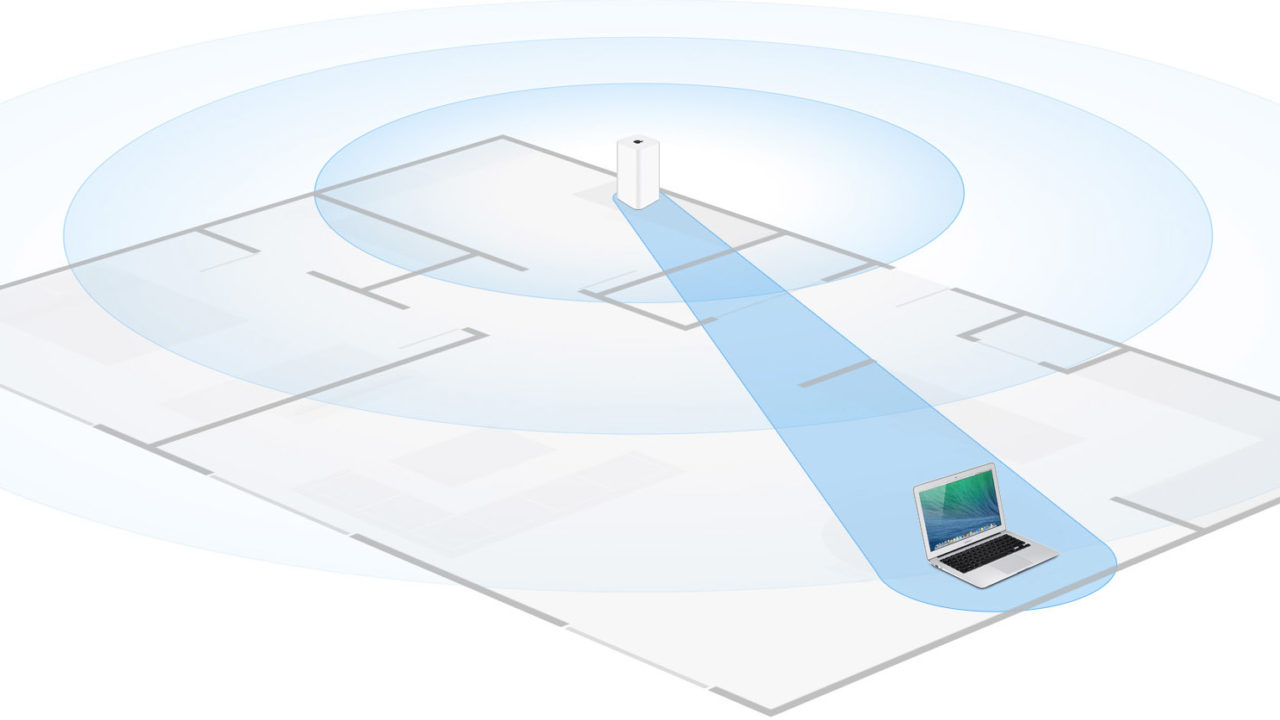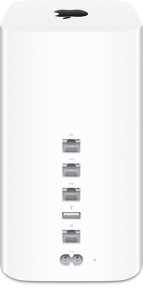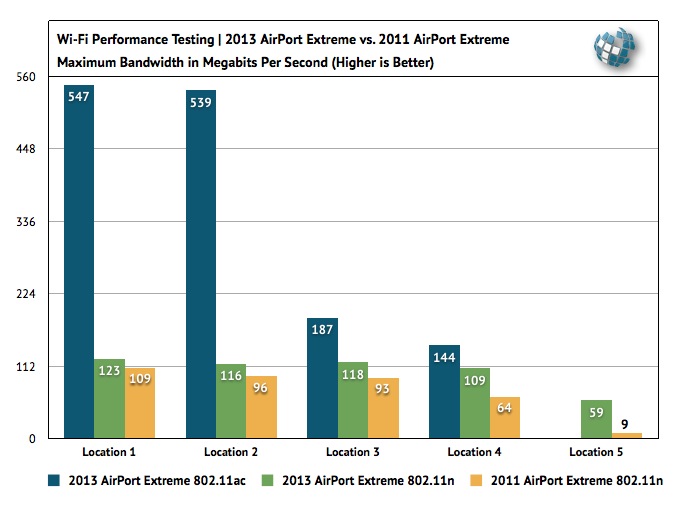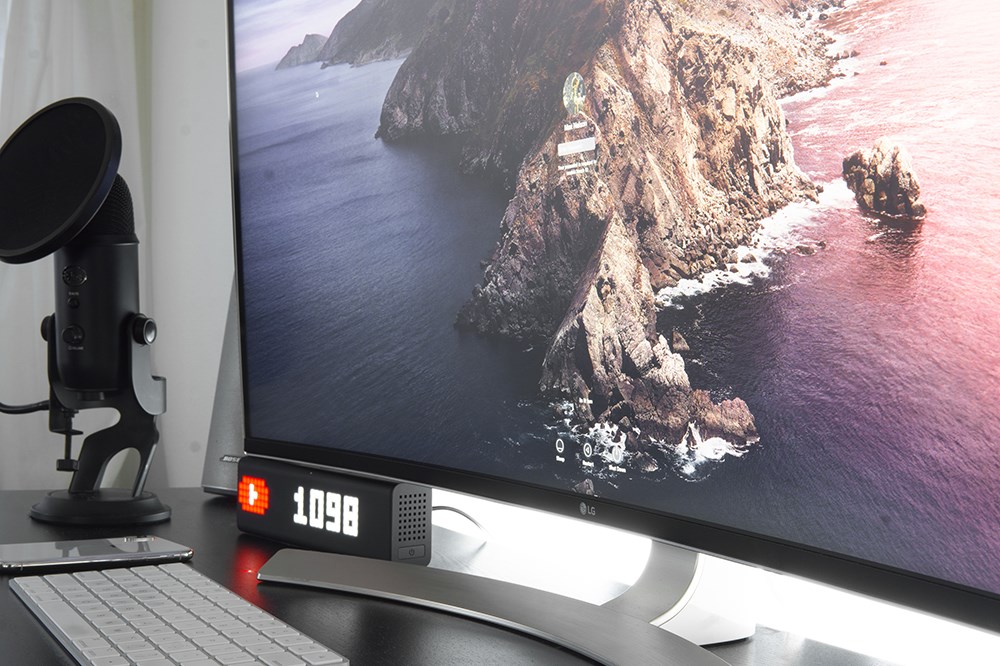Pure Speed: 2013 802.11ac AirPort Extreme Benchmarks


Update: In addition to the AirPort Extreme tests, below, we now also have performance benchmarks comparing the AirPort to other 802.11ac-class routers from Belkin, Netgear, and Linksys.
After our initial AirPort Extreme and MacBook Air demonstrated hardware problems, we waited several days to obtain replacements, which have finally arrived. While we still have much more planned in terms of reviewing the new AirPort Extreme, we wanted to get you some preliminary bandwidth numbers as quickly as possible, so here are our 2013 802.11ac AirPort Extreme benchmarks.
Our testing hardware consisted of the aforementioned 2013 AirPort Extreme (802.11ac and 802.11n), a 2011 fifth generation AirPort Extreme (802.11n), and a 2013 13-inch MacBook Air. We connected one router at a time and then measured maximum bandwidth from different locations relative to the routers.
The tests were run six times at each location, twice each for the following configurations: 2013 AirPort Extreme with 5GHz 802.11ac, 2013 AirPort Extreme with 2.4GHz 802.11n, and 2011 AirPort Extreme with 2.4GHz 802.11n. We disabled all other wireless equipment during the tests, including cordless phones and other mobile devices.
The routers were located on the main floor of our office on a bookshelf approximately five feet from the floor. The testing locations were the following:
Location 1: The same room as the routers, on a wooden table approximately ten feet away.
Location 2: One floor beneath the routers, in a room directly underneath. Approximately 15 feet from the routers through a single wood floor.
Location 3: The same floor as the routers, in a room on the opposite side of the building; approximately 45 feet away through two walls.
Location 4: One floor above the routers, in a room on the opposite side of the building; approximately 50 feet away through three walls and a wood floor.
Location 5: The maximum distance at which we could still reliably connect to the 2011 AirPort Extreme; outside the building (same floor as the routers), down the street about half a block. Note that 802.11ac, stuck in the shorter range offered by 5GHz, was unable to connect at this location, so the test only compares 2.4GHz 802.11n between the 2013 and 2011 AirPort Extremes.

As you can see, speeds from 802.11ac at relatively close distances are significantly faster than 802.11n. We achieved nearly 550Mbps (68.75 MBps) when near the router, and speeds remained over 500Mbps even one floor down. When we started getting further away, 802.11ac lost significant bandwidth, but still noticeably outperformed 802.11n.
So it’s clear that this new wireless specification is going to be a game changer for mobile devices and laptops. But you’ll need to buy new 802.11ac compatible equipment to obtain these speeds. What about those with 802.11n hardware that want to future-proof their router? Is the new AirPort Extreme a good investment?
The answer depends on your needs. At close distances, the new Extreme does indeed offer faster performance via 802.11n, but only by about 10 to 15 percent. That minor performance improvement may not be worth the minimum $200 cost of entry.
At large distances, however, the new Extreme maintains a significant advantage over the previous generation model. In our testing, the new Extreme maintained slow, but useable speeds at and beyond the transmission limit of the 2011 Extreme. If you’re looking for your 802.11n signal to reach just a bit further, and you don’t want to go through the process of setting up wireless extenders, the new Extreme may be the way to go.
That’s not to say that performance is the only factor. As we mentioned above, we’re still working on a more detailed review that will take a look at reliability, operating temperatures, and other features, as well as an overall comparison of the new Extreme to other 802.11ac routers. We’ll have that data for you in the coming days, but we just wanted to get these preliminary bandwidth numbers out as soon as possible considering the delays caused by the faulty hardware.

















16 thoughts on “Pure Speed: 2013 802.11ac AirPort Extreme Benchmarks”
802.11ac at 5GHz, broadcast by any router, has shorter range than 2.4GHz 802.11n. The primary benefit of 802.11ac is *speed* not range.
At large distances, however, the new Extreme maintains a significant advantage over the previous generation model. In our testing, the new Extreme maintained slow, but useable speeds at and beyond the transmission limit of the 2011 Extreme. If you’re looking for your 802.11n signal to reach just a bit further, and you don’t want to go through the process of setting up wireless extenders, the new Extreme may be the way to go.
802.11n @ 2.4GHz only (2011 MacBook Air): 112 Mbps
802.11n @ 2.4GHz (MacBook Air) with 802.11g Samsung Smart TV on the network: 51 Mbps
Haven’t done range testing yet, but speed is obviously much worse when the network is “polluted” with older specs.
So in support and reviews people often don’t have the opportunity to reply privately and ask if they found a solution or if there is one channel that you should absolutely avoid and should I be naming my SSID also 5ghz. I’m sorry and some may say google this stuff. Well you know what I did, and it took me here. Ha.
I did find an app where I could see channels being used etc… I’ve reset the airport extreme many times . I’ve called comcast, which blames Apple, etc. since i don’t have an ethernet I can connect from my macbook air to the cable modem… since Apple decided they could get rid of that.
I have a 3rd generation airport extreme, which I was using as a repeater (but a wifi, no ethernet wired up to it which I guess defeats the purpose?) can anyone help? or offer their own experiences anyway, or what happenned with you Nikhill?
Right now there are 5 other SSIDs MBA is picking up, none of them having a 5ghz SSID I don’t know what I’m doing. LOL I apologize for the lengthy post.
Have you considered powerline adapters? Newer models are significantly better than those from a few years ago.
Okay, here are some results using the Wi-Fi Menu Bar Transmit Rate. These measurements were taken at “Location 2” referenced in the article.
2013 13-inch MacBook Air 802.11n @ 2.4GHz: 145
2013 13-inch MacBook Air 802.11ac @ 5GHz: 351
2011 13-inch MacBook Air 802.11n @ 2.4GHz: 130
2011 13-inch MacBook Air 802.11n @ 5GHz: 262
Again, these are “artificial” numbers and real-world performance will vary. Also remember that 150 is the theoretical maximum at 2.4GHz and 300 is the maximum for 802.11n at 5GHz.
If you have another computer that’s hardwired into your network, download and run Jperf (http://jesterpm.net/downloads) and you’ll be able to test actual speeds.
In any case, I’m happy I could at least get 270 in the bedroom. It made the initial Time Machine backup over twice as fast.
It would be interesting to have other readers test their results with both the 2013 and older routers.
We don’t have a 2008 Mac to test, but we do have 2011-era MacBook Airs and Pros. We’ll do some testing this weekend and report back.
Just so we can make sure we’re testing under similar conditions, how are you performing your tests and measuring your results?
I measure my results by clicking on the wifi icon in the menu bar with the option key held down. The router is in the same place the old one was except the cord is shorter, so it is maybe five feet off the ground rather than 6.5. It’s in the bedroom and I’m normally in the living room maybe 15 feet apart, with two walls between. Does this give you enough information?
Some things to consider: First, what frequency are you using to connect to the new AirPort Extreme (2.4GHz or 5Ghz)? There’s a maximum transmission rate, even for 802.11n, at 2.4GHz and I think it’s 150Mbps (I can’t recall for sure). So if the new router defaulted to 2.4GHz when you set it up, you may be unknowingly stuck on that frequency. That doesn’t explain why it’s slower than your old 802.11n router if it was in the same mode, but it does explain why you’re not getting significantly improved speeds. At 5GHz, the maximum rate for standard 802.11n implementations is 300Mbps.
Second, what results do you get when you’re in the same room as the router? I know it’s not where you regularly use the MacBook, but it may help determine if the problem is inherently hardware in the router or a settings issue.
Also note that our tests measure actual bandwidth between the MacBook and a hardwired server attached to the router. The Transmit Rate reported by the Wi-Fi menu bar icon is the current maximum connection speed, but real world transfers will always differ from that number. I mention this because it may be possible that the new router is performing the same or slightly better in real world usage, while reporting this slower generic transmit rate. So, aside from the lower rate, do you notice a difference? Do webpages and downloads take longer than they used to, or are local network file transfers slower? Shorter range?
Thanks,
Jim from TekRevue
I tried it in the same room just now and it actually dropped from 108 to 81.
A few months ago when I was having other wifi problems (my MBP needed a new Airport card), I tried the 2012 Airport Express and consistently got 270.
I recently also upgraded the MBP to a solid state drive, so everything is faster now. It’s hard to compare the 130 from my old Airport Extreme and the current 108 or lower. Safari usually doesn’t seem slow to me now, depending on the page, of course. But I’m backing up over wifi with Time Machine so the speed matters there.
I ran an small hostal in Mexico with 2 of the last gen airport extremes in (1 in bridge mode)… I will upgrade the network to 100Mbps and I have not decided yet if I should buy these new routers… or if I should go to other solution. does it really handle 50 clients at a time? should I buy it and use it as the primary router or should I pick the Trendnet’s AC1750 router ?
My main concern is to actually handling 50 clients at a time with solid (20-30 Mbps) connections each. Currently with the last gen airports I´m handling like 20 – 25 client with solid connections each.
Not planning to require more than 50 clients at a time, and as I am a very small customer availability of enterprise products is extremely limited for me in Mexico.
I mean I would love a Cisco or Procurve enterprise router… but they wont even sell it to me, so I need a commercial product.
I could alternatively get two broadband connections from the ISP and have the routers handle 25 clients each… but if this one really handle 50 at a time, why bother?
We’re also a small business and so we don’t have 50 devices to test with the AirPort Extreme simultaneously. But, aside from our initial faulty unit, the experience has been very solid. The unit runs cool and quiet, and we have about 18 devices (PC and Mac laptops, smartphones, tablets, smart TVs, our Nest Thermostat) connected simultaneously with no problem.
Apple does advertise 50 users and we’ve seen nothing in our experience with the new Extreme to make us doubt that claim. But we can’t say for sure; you may wish to contact Apple directly.
The Trendnet AC1750 should also work; it has received mostly positive reviews. It also offers an additional gigabit Ethernet port, but I can’t find any documentation that lists a user limit, so you’ll also need to verify that to make sure it meets your needs.
Indeed, we left out the paragraph on the testing process (that’s what we get for trying to push an article out at 2 AM).
These were straight TCP connections utilizing Iperf/Jperf with a wired iMac acting as the server. As you point out, there is already news about slower performance via AFP. AnandTech has an excellent discussion of this http://www.anandtech.com/show/7085/the-2013-macbook-air-review-13inch/10.
We saw the same thing in our initial testing, which will be looked at further in our full review. Our purpose here was to get some data on maximum performance aside from the AFP issue. Thankfully, the slow speeds are the result of software, and Apple will almost certainly release software updates for OS X 10.8 to correct the problem (and we’re sure that it will be fixed out of the box for Mavericks).
Thanks for the feedback!